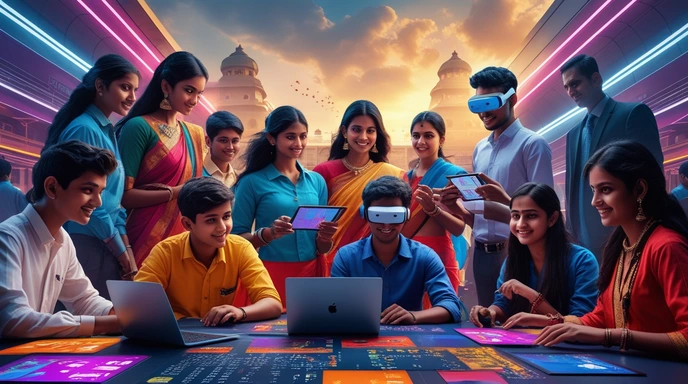India, a nation with a vast and diverse population, has long grappled with the challenges of providing quality education to all. However, a digital revolution is underway, and it’s transforming the way Indians learn. The rise of EdTech in India is not just a trend; it’s a significant shift that promises to reshape the educational landscape. This article will examine the driving forces behind this transformation, the key players in the field, and the opportunities and challenges that lie ahead for online education in India.
Table of Contents
A Digital Leap: EdTech’s Ascendancy in India
The education sector in India is undergoing a massive transformation, driven largely by the rapid growth of educational technology (EdTech). Once a relatively niche area, EdTech has now become a significant force, impacting how students learn, how teachers teach, and how educational institutions operate. From online tutoring platforms to comprehensive learning management systems, digital tools are changing the face of education in India. This surge is propelled by increased internet penetration, growing smartphone usage, and a rising demand for accessible, high-quality learning resources, especially during and after the pandemic.
The Genesis: Why India Embraced EdTech
Several factors have converged to create the perfect storm for the rise of EdTech in India. Firstly, the traditional education system, while extensive, has struggled with issues of accessibility, quality, and scalability, especially with the sheer size of India’s population and geographic diversity. 👩🏫 Secondly, the aspiration for better learning outcomes among students and parents has fueled the demand for supplementary and personalized learning options. Additionally, the COVID-19 pandemic acted as a catalyst, forcing a rapid adoption of digital learning tools and showcasing the potential of online education. 💻 This sudden shift pushed educators, students, and parents to rapidly adapt, accelerating the acceptance and growth of edtech solutions in India.
Democratizing Access to Quality Education
One of the most significant impacts of EdTech in India is its ability to democratize access to quality education. 🧑🎓
- Bridging the Urban-Rural Divide 🏘️: EdTech platforms are breaking down geographical barriers, allowing students in remote areas to access resources and teachers previously unavailable to them. Online classes and digital learning materials are bringing high-quality instruction to underserved communities.
- Catering to Diverse Learning Needs 🧑🏫: Different students learn in different ways. EdTech provides diverse learning formats, including video lessons, interactive quizzes, and personalized learning paths. This customization allows students to learn at their own pace and according to their specific learning styles.
Key Players in the EdTech Arena
The Indian EdTech market is populated by a mix of established players and innovative startups, all vying to capture a piece of this rapidly expanding pie. 🚀
- The Rise of Unicorns: A Look at the Major Companies 🦄: Companies like BYJU’S, Unacademy, and Vedantu have achieved unicorn status, reflecting the huge market value and potential of edtech companies in India. These platforms offer a range of services from test preparation to K-12 education.
- Diverse Approaches to Learning: Beyond the big names, a multitude of EdTech startups are focused on specific niches such as coding, skill development, or vocational training. These platforms are using diverse approaches, from gamified learning to AI-powered personalized experiences, to cater to the different learning requirements of students.
Navigating the Challenges
Despite the remarkable growth, EdTech in India faces several challenges that need to be addressed for the sector to reach its full potential. 🤔
- Digital Divide and Infrastructure Limitations 🌐: While internet penetration is increasing, many parts of India still lack reliable internet access and the necessary hardware (laptops, smartphones) to fully participate in online learning. This digital gap disproportionately affects rural and low-income populations.
- Ensuring Quality and Effectiveness 🎯: The rapid expansion of EdTech has raised concerns about the quality of content and the effectiveness of online learning methods. Ensuring learning outcomes and maintaining high educational standards is a critical challenge.
- The Issue of Affordability and Accessibility 💰: While EdTech can make education more accessible, the cost of devices and subscriptions remains a barrier for many families, particularly in rural areas. Balancing affordability with sustainability for EdTech companies is crucial.
Government’s Role in Propelling EdTech
The Indian government has recognized the potential of EdTech and has taken several steps to support its growth and development. 🇮🇳
- Policy Support and Initiatives 📜: The government has launched various initiatives, including the National Education Policy (NEP) 2020, which emphasizes the use of technology in education. These policies aim to integrate technology into the mainstream curriculum and promote digital literacy.
- Driving Digital Literacy 💻: Several government programs focus on improving digital infrastructure and promoting digital literacy, especially in rural areas. These initiatives seek to equip more students and teachers with the skills needed to fully engage in the digital learning environment.
What’s Next for EdTech in India?
The EdTech sector in India continues to evolve and innovate, and the future looks very promising.
- Personalized Learning Experiences 🤖: With the help of artificial intelligence (AI), EdTech platforms will offer increasingly personalized learning paths tailored to each student’s individual needs and pace, allowing for a truly customized education experience.
- The Role of AI and Emerging Technologies ⚙️: AI, machine learning, and augmented reality (AR) are set to play an increasing role in EdTech, enhancing engagement, improving assessment methods, and creating more immersive and interactive learning environments.
- Expanding Reach and Impact 🌍: EdTech is not just about supplementary education. The sector is poised to expand its reach into areas like vocational training, corporate learning, and lifelong learning, offering a wide range of opportunities for learners of all ages.
EdTech’s Transformative Power
The rise of EdTech in India is a testament to the transformative power of technology. 💡 It holds immense promise for revolutionizing the educational landscape, making quality learning more accessible, affordable, and effective for all. While there are challenges to overcome, the potential benefits are clear. EdTech isn’t just changing how India learns; it’s shaping the nation’s future. For those interested in learning more, visit the official website for the National Education Policy (NEP) 2020. This policy is a critical factor in driving EdTech adoption in the country.

